- Home
- Blog
- Industry Sharing
- How to install handrail brackets?
How to install handrail brackets?
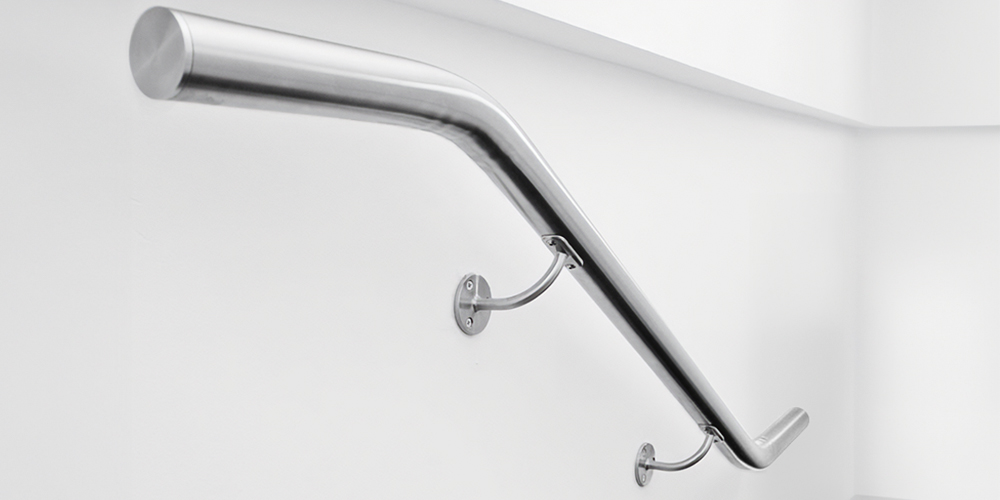
What is handrail bracket?
A handrail bracket is a hardware component used in construction and architecture to support staircases, balconies, ramps, and other locations where handrails are required for safety and accessibility. It is used to attach a handrail to wall, post, or other surface.
< Related Products : Glass or Wall Handrail Mounted Bracket >
Handrail brackets are divided into two types:
- Handrail mounted brackets are designed to have a clean space under the handrail so that it can be attached to the wall or glass.
- Handrail post brackets are designed to saddle the handrail on to the post to prevent people from falling through and to create a prohibited area. Normally, we install glass or cable between the posts.
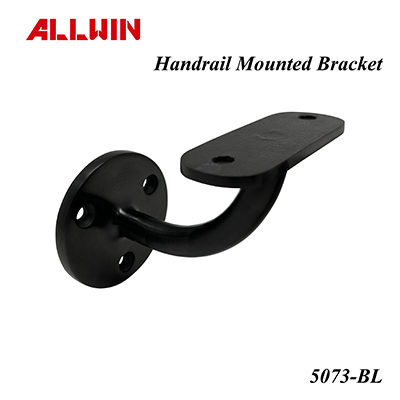
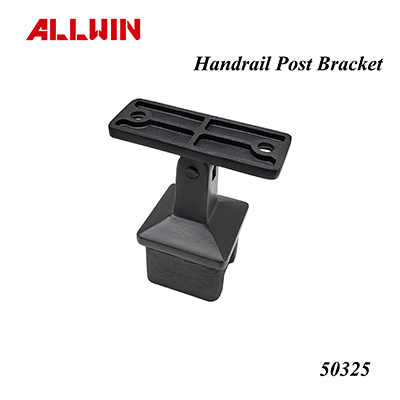
The article will primarily focus on handrail mounted brackets.
Handrail brackets are typically made of metal, wood, or other sturdy materials and come in various designs and styles to match the aesthetics of the surrounding architecture.
When searching for handrail brackets, you may notice that wall-mounted and glass-mounted brackets are available. They look similar, but how can you tell the difference?
It's not hard. The main difference is the surface that they are attached to. Wall-mounted brackets are used on solid vertical surfaces like walls or posts, while glass-mounted brackets are designed to attach handrails to glass panels in modern railing systems. The choice between the two depends on the specific architectural and design requirements of the project and the materials being used.
< Video of Handrail Mounted Bracket >
Styles & materials of handrail bracket
Style
The style of a handrail bracket is often determined by its appearance, but its functionality is actually a critical factor in installation. For example, the difference between round and square handrail brackets is usually in the base, but if the structural design of the handrail bracket that connects to the surface is not chosen correctly, the part may not be able to be successfully installed.
As shown in the two images below, two handrail brackets with the same square base can be connected to round and square handrails, respectively. Therefore, do not assume that a square handrail bracket can be installed on a square handrail at first glance. Ignoring this detail can lead to time and money wasted. As a trusted supplier, we always carefully confirm customer needs to provide the best hardware solutions.
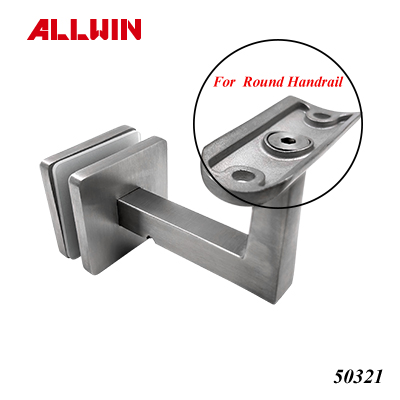
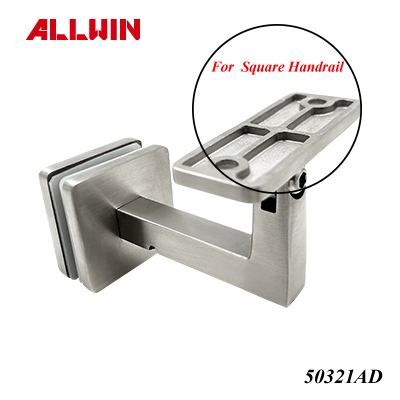
Material
Material is a key consideration when choosing a handrail bracket. It affects the cost, durability, and appearance of the bracket.
The cost and performance of handrail brackets vary depending on the material used. Metal brackets are generally more expensive than plastic brackets, but they offer better durability and safety. This makes them a good choice for modern industrial architectural designs.
-
Wood: Wood is a natural and beautiful choice for handrail brackets, suitable for traditional and classical design styles. It provides a warm and natural look. It can be made from a variety of wood types, including oak, maple, and pine.
-
Stainless Steel: Stainless steel is a very common choice for handrail brackets because of its high durability, high loading strength, high corrosion resistance, and modern appearance. It is widely used in both indoor and outdoor applications.
-
Brass: Brass has a unique golden hue that adds an elegant touch to handrail brackets. It is suitable for traditional or classical designs. However, it is more expensive than other metals and requires regular maintenance to keep its luster.
-
Aluminum: Aluminum is also a corrosion-resistant and easy-to-maintain material, with a low cost and ease of processing. However, it is lightweight, making it suitable for light-duty applications only.
-
Plastic: Plastic has the advantages of being lightweight, corrosion-resistant, inexpensive, and easy to maintain. However, it also has some limitations, such as low strength and poor performance in high-temperature environments.
Suggested Handrail Bracket Spacing
In fact, there are no specific regulations on handrail brackets spacing in most countries. However, according to the experience of the construction industry, we recommend that handrail brackets spacing should be between 36 and 48 inches, or about 3 to 4 feet (7.62-10.16 cm). However, the actual spacing needs to be determined based on the length of the handrail.
How many handrail brackets are needed for a handrail?
After you have chosen the right handrail brackets, the next question is how many you need. The answer depends on several factors, including the length of the handrail, the type of bracket, and local building codes.
For example, if the total length of the handrail is 3600mm, according to common installation experience, the handrail brackets spacing between each bracket is 1000mm, and the spacing between the bracket and the ends of the handrail is 300mm. In total, 4 handrail brackets are required. Understanding the concept of handrail brackets spacing can help you quickly estimate the number of brackets needed, making it easier to communicate with designers or suppliers.
How to install handrail brackets?
Installing handrail brackets is just one step in the entire handrail installation process. There are many factors to consider, including compliance with local building codes, the type and number of brackets, the accuracy of the pre-installation distance measurement, and the availability of all tools.
Tools you need:
- Handrail brackets
- Handrail
- Screws appropriate for the bracket and wall material (usually provided with the bracket)
- Screwdriver or drill with the appropriate bits
- Level
- Measuring tape
- Pencil
- Wall anchors (if necessary, depending on wall type)
The following 4 steps:
1. Determine the height of the handrail
Handrail heights for indoor stairs and public spaces must comply with local building codes. For example, public buildings in the United States must comply with the Americans with Disabilities Act (ADA) standards. The height of handrails on accessible ramps must be between 34 and 38 inches.
2. Determine the position of the handrail brackets
Use a measuring tape, level, and pencil to mark the positions on the wall at 36 to 48 inches. Next, use a drill with the appropriate bit to create holes at the marked locations. The holes should be centered on your pencil marks and match the size of the screws provided with the brackets (if any). Pre-drilling the holes makes it easier to attach the brackets securely to the wall.
3. Install the handrail brackets
Once you have marked the bracket locations, attach them to the wall by positioning a bracket over a drilled hole. Insert a screw through the bracket and hole, then secure it with a screwdriver or drill.
Handrail brackets may have different numbers of screw holes, and the installation method may also vary.
4. Install the handrail and inspection
Congratulations! You have reached the final step. Slide the handrail onto the brackets you've installed on the wall. Each handrail has its own installation method, and you may need to use the installation kit provided by the supplier to effectively secure it to the brackets. After all the steps are completed, don't forget to re-inspect, including the height of the handrail, the spacing and angle of the brackets, and whether they are installed securely to ensure safety.
Handrail brackets play a vital role in both safety and aesthetics in construction and architecture. Careful consideration of style and material is essential to harmonize form and function when selecting handrail brackets. Additionally, determining the required quantity of brackets is a crucial aspect, guided by factors such as the length of the handrail and local building codes. The installation process, which involves precise measurements, suitable tools, and adherence to regulations, ensures a secure and visually appealing handrail system. Attention to these details is essential for creating spaces that are both safe and visually appealing.
How to Care for Handrail Brackets
Maintaining your handrail brackets is key to ensuring their longevity and safety. Here are some care tips, with specific advice for different materials:
Regular Cleaning
- Stainless Steel: Wipe the surface with a damp cloth, using a neutral detergent to remove stains. Avoid using acidic or alkaline cleaners, as these can corrode the metal surface. You can use a stainless steel-specific polish to maintain its shine.
- Aluminum Alloy: Wipe dust and dirt with a damp cloth. If oxidation occurs, use a specialized aluminum alloy cleaner.
- Wood: Use a dry cloth or a slightly damp, soft cloth to wipe the surface. Avoid prolonged contact with moisture to prevent warping or mold. You can regularly use wood wax oil or a protective agent to prevent cracking.
- Iron (Galvanized or Painted): Preventing rust is key. Use a dry cloth to wipe the surface. If rust appears, use sandpaper to gently remove it and apply a rust-resistant paint.
〈Extended reading: How to Choose the Right Architectural Railing Hardware?〉
Inspecting Screws and Fasteners
Regularly inspect the screws securing the brackets to the wall, handrail, and other components to ensure they are not loose. If you find any loose screws, tighten them immediately to maintain safety. Additionally, check the mounting points for any cracks or shifts, as these could compromise the brackets' load-bearing capacity.
Avoid Overloading and Impact
To prevent the handrail brackets from loosening or becoming deformed, avoid placing heavy objects on the handrail whenever possible.
Important Considerations for Installing Handrail Brackets
Ensuring Bracket Stability
If handrail brackets are not installed correctly, they may become loose or unstable, making users feel unsafe and even increasing the risk of accidents. This issue is often caused by substandard screws or brackets made from inferior materials.
Choosing Durable Bracket Materials
Some brackets are made from materials that lack durability, making them susceptible to rust, deformation, or damage—especially in humid environments. This can significantly reduce their lifespan.
Ergonomic Design
If the height or angle of the handrail brackets is not properly adjusted, users may experience discomfort or difficulty gripping them. This can be particularly challenging for the elderly and individuals with mobility impairments.
Ensuring Sufficient Brackets
Some stair designs may lack enough handrail brackets or have them installed only in certain areas. This can increase the risk of falls, particularly for the elderly.
These issues can typically be prevented or resolved by choosing the right materials, ensuring proper installation, and conducting regular inspections. If you notice any problems with your handrail brackets, repair or replace them promptly to maintain safety.
Conclusion
By following these guidelines, you can design a handrail system that is both aesthetically pleasing and highly functional, ensuring safety and security.If you have any questions about ALLWIN handrail brackets, please feel free to contact us.
<Extended reading:Do handrails need end caps?>
Article Classification
Recent Articles
- The Definitive Guide to Stainless Steel Manicure Scissors: Types, Materials, and B2B Quality
- Stainless Steel Nail Clipper: Complete Guide, Types, Care Tips, and Great B2B Solutions
- Tactile Paving: Essential Types, Standards, and B2B Procurement
- The Essential B2B Guide to Aluminum Tube Connectors: Types, Applications, and Connection Methods
- Stainless Steel Screw Bolts: Grades, Types, and Supply for B2B Projects

